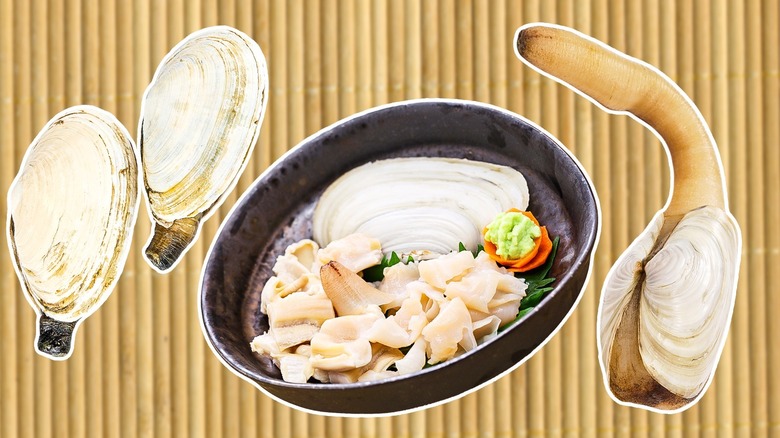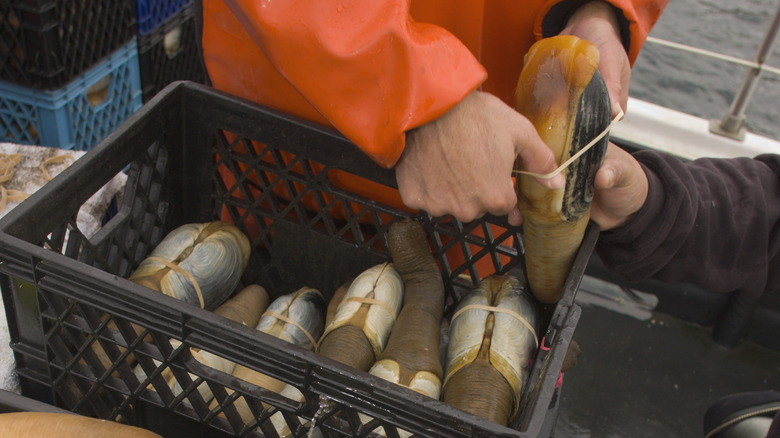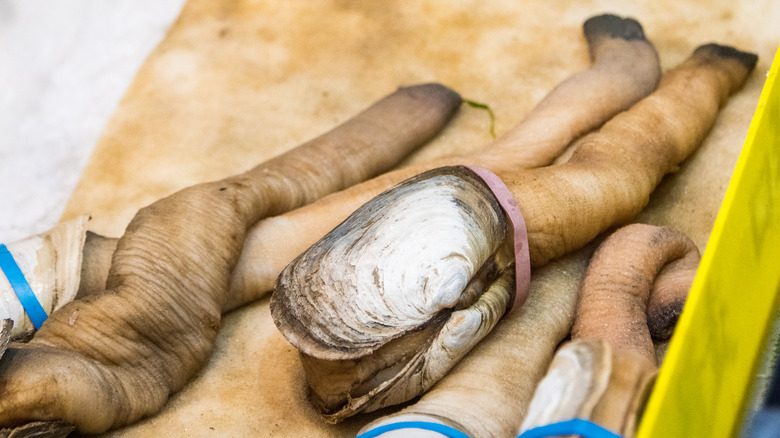Geoduck: The Odd-Looking Shellfish That's Way Easier To Cook Than It Seems
Once you move past common favorites like shrimp and salmon, there's an astonishingly diverse seafood world out there. One especially fascinating — not to mention tasty — category is mollusks. These shell-on creatures cover the range from the archetypal French escargot to clams or mussels (which have a few differences). A particular variety you shouldn't miss is the geoduck — once you see this interesting-looking shellfish, you won't soon forget it.
This very large clam is the biggest burrowing variety in the world. An average specimen weighs 2 to 3 pounds, although they've been known to reach 8. Its appearance is certainly fit to inspire at least a little giggle — let's just say the Chinese word for the creature translates to "elephant trunk" thanks to a long, root-like protrusion that can grow up to 3 feet in length.
While its appearance is rather odd, geoduck is surprisingly tasty and simple to prepare. The flavor is delectable: marine, very clean, and among the sweetest of the clam varieties. Its consistency is also fascinating. The long neck has a palatable, snappy crunch that necessitates thin slicing, and it shines as sashimi or sushi (in case you're curious, here's the major difference between the two). Meanwhile, cook the clam's body with a bit of heat, and you'll be able to meld it with countless flavors.
This clam shines with minimal preparation
With its uber-fresh sea flavor, there's no need to overcomplicate cooking geoduck. You'll need to start with some easy prep since the protruding clam neck is surrounded by a thin membrane. To remove it, briefly blanch it in hot water, and it'll slide right off. Afterward, this portion of the geoduck is ready for thin slicing and raw enjoyment. The thicker the texture, the more crunch, so remember to slice thinly — you might even want to sharpen your knife for this one.
The clam's gentle, marine flavor shines alongside mild, texturally interesting vegetables: Think cucumber, fennel, or perhaps avocado. Alternatively, layer it atop a salad with vibrant herbs like mint or deeper-flavored collard greens. Alternatively, cover it with an Asian-inspired soy sauce vinaigrette. The pairing possibilities are endless — the clam is even delicious as a crudo-style appetizer.
The portion of the clam that's inside the shell is a bit tougher, so it'll need a quick heat application. A light sear is all it takes, perhaps with a butter baste for a bit more richness. You can also briefly stir-fry it in a hot wok, along with some finely chopped aromatics. In China, the clam is often steamed, complemented with the nation's popular green onion flavor (it's even used in coffee). Asian cuisine also incorporates geoduck into hot pot, a culinary experience which can be enjoyed in cities throughout the Pacific Northwest.
Seek out specialty sellers to locate geoduck
Finding this clam is no easy task due to both its burrowing tendencies and limited availability. The majority of harvesting occurs in Washington state, although there's also some in Oregon and British Columbia. About 90% of it gets exported to Asian markets, where demand for foreign seafood fetches high prices (via BBC). Even in the U.S., the clam typically sells for around $30 per pound.
For residents of the Pacific Northwest, foraging for geoduck is a popular pastime. This practice continues a centuries-old Native American cultural tradition. The Nisqually tribe first lent the ingredient its name, originally calling it "gweduc." Today, a permit is necessary for such a practice, along with a limit on daily clam hauls. Unfortunately, geoduck is subject to sustainability issues in both farmed and wild settings, further complicating distribution.
One of the most well-known purveyors is Taylor Shellfish, which is the largest distributor in the country. It ships geoduck nationwide, if you're looking to get some into your home kitchen. A handful of other sellers also sell the clam online, some of which come pre-cleaned. Whichever way you've purchased the clam, it's possible to store the living organism in the fridge for optimal freshness. Just wrap it in a moist paper towel and keep it in the bottom drawer. It'll last up to four days in this format. If you've been blessed with an abundance, you can freeze it, too — just be aware that this will worsen the raw-eating experience.


